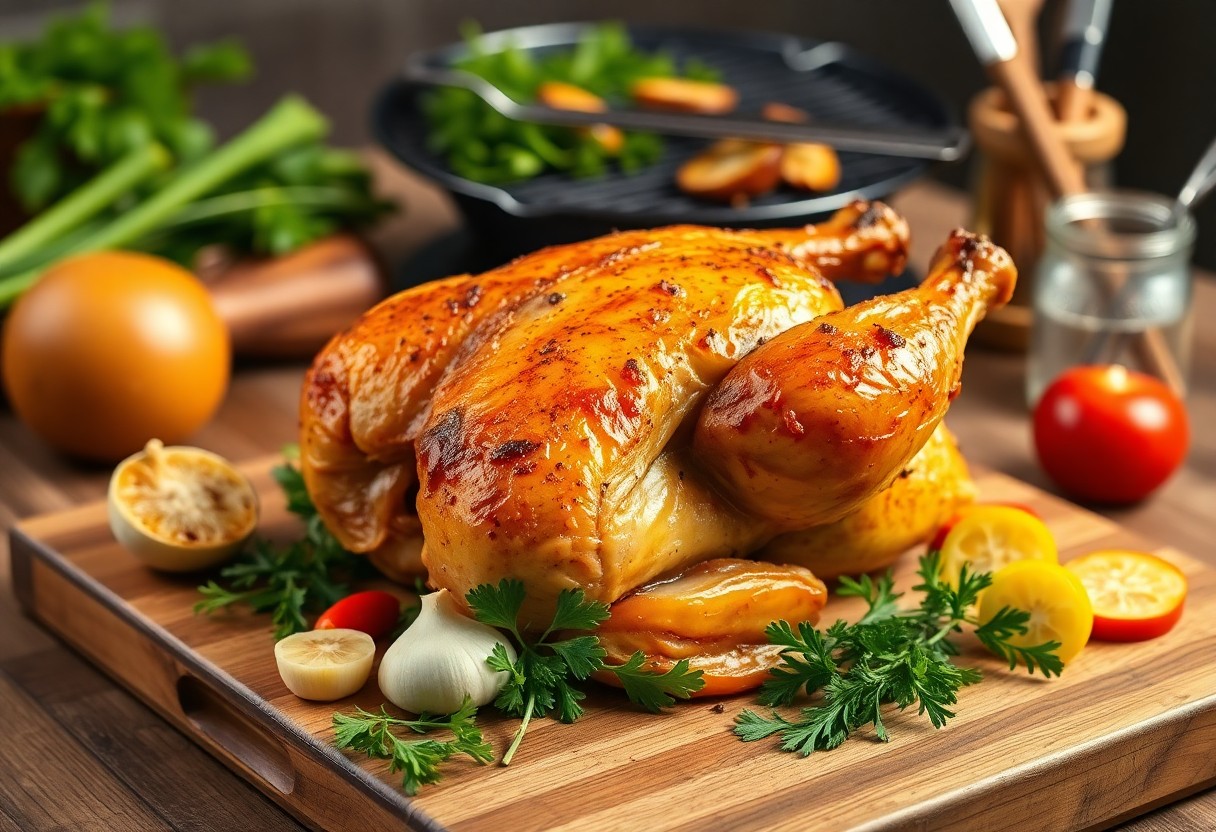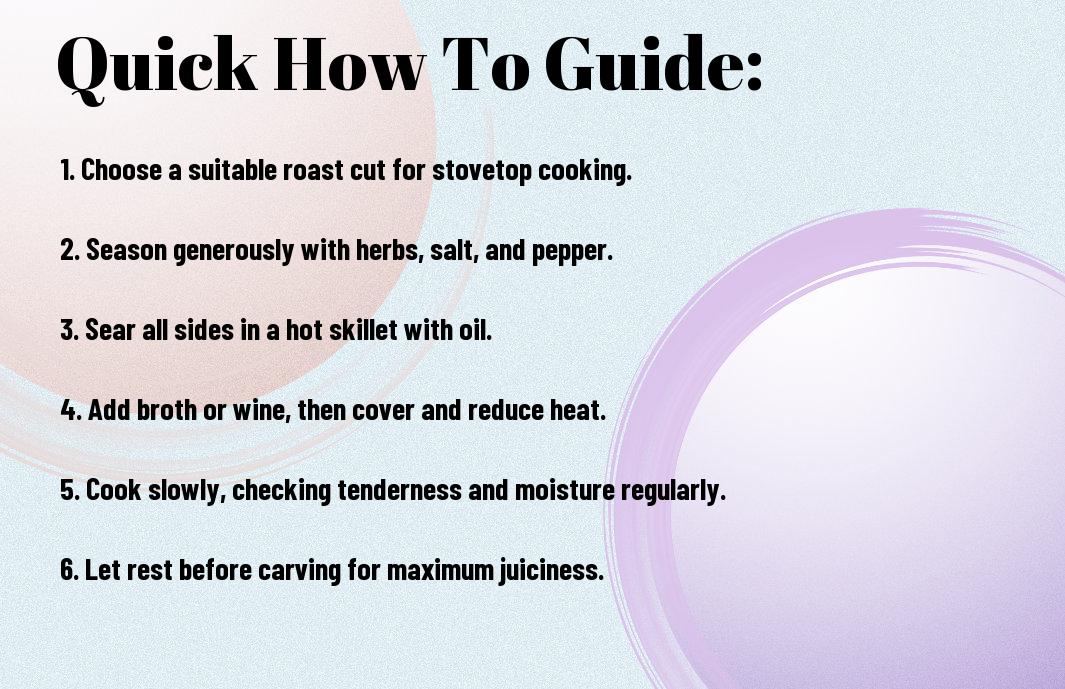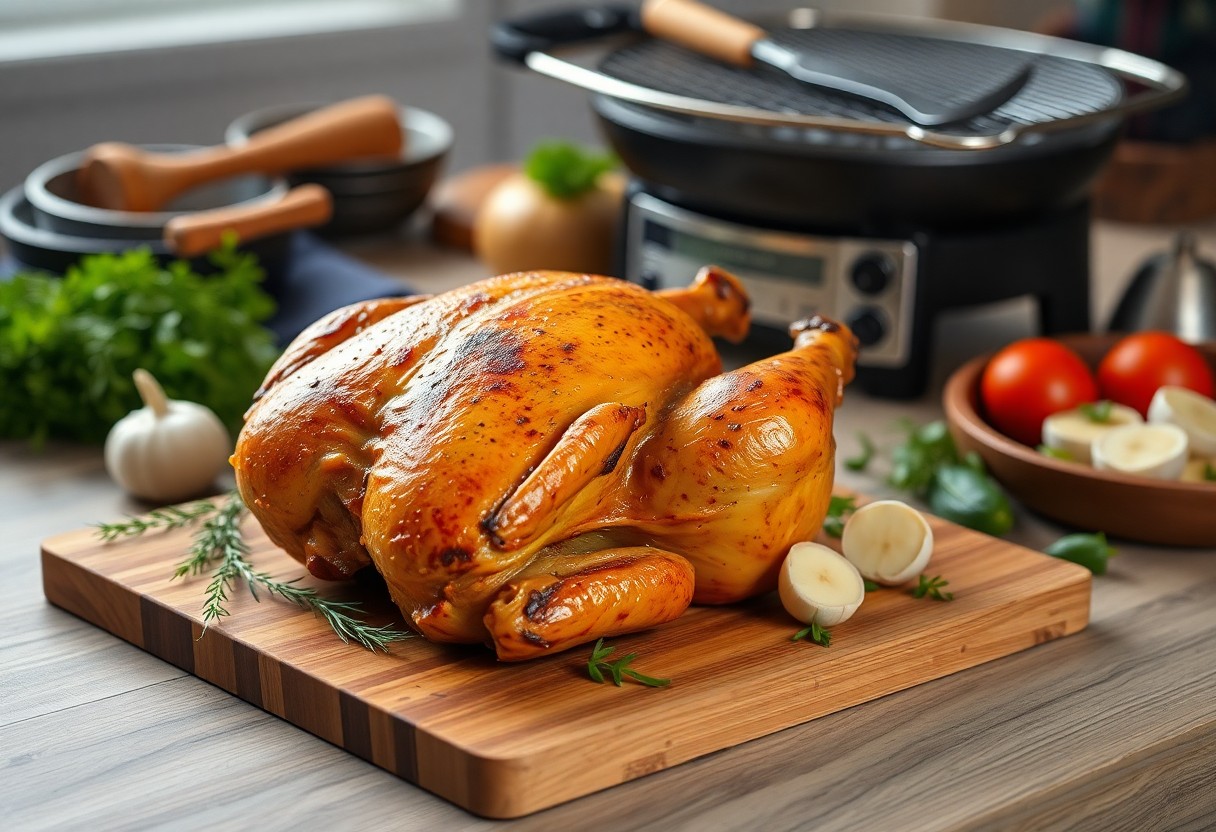There’s no need to fret if your oven is out of commission; you can still achieve a mouthwatering roast with a few smart techniques. Whether you opt for a slow cooker, stovetop, or grill, cooking a roast to perfection is absolutely achievable without an oven. This guide will walk you through each method, ensuring your roast is juicy, tender, and full of flavor. Let’s investigate the best ways to create a delicious roast right from the comfort of your kitchen!
Key Takeaways:
- Utilize alternate cooking methods such as slow cooking, grilling, or stovetop techniques to achieve a perfectly cooked roast without an oven.
- Seasoning and marinating the meat beforehand enhances flavor and tenderness, contributing to a delicious outcome regardless of the cooking method.
- Using a meat thermometer ensures that the roast is cooked to the desired doneness and helps avoid undercooking or overcooking.

Understanding the Roast
Before submerging into the cooking process, it’s imperative to understand what makes a roast exceptional. A perfect roast combines the right cut of meat, appropriate cooking techniques, and an understanding of various factors that affect the outcome, such as time, temperature, and seasoning. When these elements align, you can achieve that mouthwatering, succulent roast that impresses everyone at the dinner table.
Choosing the Right Cut
An important step in your roasting journey is selecting the right cut of meat. Different cuts have varying levels of tenderness and flavor. For the best results, consider cuts like ribeye, sirloin, or pork loin that suit your taste and desired cooking method.
Essential Cooking Factors
An understanding of key cooking factors will elevate your roast. These include:
- Temperature: Monitor your internal temperatures for doneness.
- Resting Time: Let your roast rest before carving for juiciness.
- Seasoning: Use a balanced mix for flavors that enhance your cut.
After you account for these factors, your roast will stand out in flavor and texture.
Roast success is not just about the meat but also the process you engage in. Consider the following:
- Cooking Method: Choose between slow roasting or high-heat roasting based on your time.
- Oven Temperature: Ensure you preheat your oven adequately for even cooking.
- Basting: This maintains moisture and flavor, especially for lean cuts.
After optimizing these details, your roast is bound to impress with its taste and texture.

Cooking Methods Without an Oven
If you don’t have an oven at your disposal, don’t worry—there are plenty of creative methods to prepare a delicious roast. Utilizing other kitchen appliances and techniques will allow you to achieve tender, flavorful results. From stovetops to slow cookers, you can still enjoy a perfectly cooked roast without missing out on your culinary goals. Let’s research into these various cooking options.
Stovetop Techniques
Clearly, using a stovetop can yield fantastic roasts. Techniques such as braising or searing followed by simmering can lock in flavors and moisture. By browning your roast first, you create a desirable crust that enhances both taste and presentation. Make sure to control the heat effectively to ensure even cooking and avoid burning.
Slow Cooker Options
Options for cooking with a slow cooker are plentiful and perfect for roasts. This method utilizes low and slow heat to break down tougher cuts of meat, resulting in a melt-in-your-mouth texture.
Techniques like seasoning your roast and adding liquid will create a flavorful environment inside the slow cooker. Maintain a consistent temperature and ensure the meat is fully submerged for best results. By cooking for several hours, you achieve a tender, juicy roast that requires minimal effort. Just set it, forget it, and enjoy the delicious aroma that fills your home while it cooks!
Flavor Enhancements
Your roast will truly shine when you incorporate various flavor enhancements. From delicious marinades to aromatic additions, these elements can elevate your dish and impress your guests. By using a combination of herbs and spices, you can create a flavor profile that’s unique to your taste preferences. Exploring different culinary techniques and ingredients will ensure that your roast is not just good, but exceptional.
Marinades and Rubs
If you want to maximize flavor in your roast, consider using marinades and rubs. Marinades typically consist of an acid, such as vinegar or citrus juice, combined with herbs and spices to infuse flavor. Alternatively, dry rubs can create a savory crust, enhancing both taste and texture. Apply your chosen marinade or rub several hours or even a day in advance for optimal results.
Aromatic Additions
While marinades and rubs provide bold flavors, incorporating aromatic additions can deepen your roast’s profile. Herbs like rosemary and thyme, along with spices such as garlic and onion, unleash their natural oils when cooked, creating a fragrant and flavorful experience. You can also include vegetables like carrots and celery in your roasting pan; they will not only add flavor as they cook but also create a delicious base for gravies or sauces.

With your choice of aromatic additions, you’ll transform your roast into something truly special. Adding fresh herbs not only brings out the best in your dish, but their necessary oils release enticing aromas, making it a feast for the senses. Onions and garlic, when roasted, become sweet and rich, providing a savory depth you won’t want to miss. Furthermore, incorporating citrus peels like lemon or orange can introduce a bright note that perfectly balances the rich flavors of the meat. Embrace these aromatic additions and watch your roast become the star of the meal!
Monitoring Doneness
All successful roasts depend on effectively monitoring their doneness to ensure perfect results. Use both a meat thermometer and visual cues to gauge your roast’s readiness. A well-cooked roast should meet your desired level of doneness while maintaining its juices and flavor.
Using a Meat Thermometer
For precise cooking, a meat thermometer is your best tool. Insert it into the thickest part of the roast, avoiding bone, and check the internal temperature. Aim for 130°F for medium-rare, 140°F for medium, or 160°F for well-done, ensuring a delicious and safe meal.
Visual Cues for Perfection
An effective way to gauge your roast’s doneness is by observing its color and juices. The exterior should be a rich, golden-brown, indicating a flavorful crust, while the juices that run when you pierce the meat should be clear and not bloody. Additionally, a slight firmness when you press on it indicates the meat is cooked through.
Cues to watch for include a golden-brown crust forming on the outside and juices running clear when poked. If you see browning, it’s a good sign your roast is developing flavor. Be cautious, though: undercooked meat poses health risks, so use these visual indications along with your thermometer for the best results. Ensuring balance in texture and internal temperature will yield a roast that is both safe and delicious.
Tips for Resting and Serving
After you’ve cooked your roast, it’s important to let it rest before serving. This process allows the juices to redistribute, ensuring every bite is flavorful and moist. Consider these tips:
- Cover the roast loosely with aluminum foil
- Let it rest for at least 15-30 minutes
- Slicing too early will cause juices to escape
Knowing how to properly rest and serve your roast will elevate your dish to perfection.
Importance of Resting Time
If you skip the resting time, you risk losing all those delicious juices that make your roast tender and flavorful. Allow your meat to sit undisturbed so the fibers can relax, ensuring a more satisfying and juicy meal when you finally slice and serve.
Slicing Techniques for Optimal Flavor
If you want to enhance your roast’s flavor, proper slicing is vital. Make sure you use a sharp knife and cut against the grain to maintain tenderness. Take your time as you slice, ensuring even portions for your guests.
Resting is important because it allows the fibers of the roast to recombine and absorb juices, enhancing its flavor and moisture. By slicing against the grain, you prevent long, stringy pieces that might be tough or chewy. Ideally, use a carving knife and cut in uniform sizes to ensure that every bite delivers the perfect combination of flavors. Follow this technique to impress your guests and keep the roast’s natural richness intact.
Troubleshooting Common Issues
Keep in mind that cooking without an oven may lead to some unexpected challenges. From achieving the right texture to making sure the flavors meld beautifully, it’s important to troubleshoot effectively. If things don’t turn out as planned, don’t worry—there are always fixes to elevate your roast. Stay calm and explore some common solutions to ensure your dish turns out just right.
Dealing with Dry or Overcooked Meat
To remedy dry or overcooked meat, you can try soaking it in a flavorful broth. This will help reintroduce moisture and enhance the taste. Additionally, slicing the meat thinly against the grain can make it more tender and enjoyable to eat. If you’ve got a sauce handy, serving the meat with it can mask dryness effectively.
Enhancing Flavor Post-Cooking
You can always improve the flavors of your roast after cooking by incorporating fresh herbs and a splash of acid, like lemon juice or vinegar. These elements can brighten the dish and add depth to the overall taste.
Another excellent technique is to incorporate rich sauces or glazes. A homemade chimichurri or a savory sauce can transform your roast into a mouthwatering centerpiece. You could also sprinkle fresh herbs like parsley or basil just before serving to provide a burst of flavor and visual appeal. Don’t hesitate to experiment with spices or condiments that you enjoy; this personal touch will take your dish to the next level while ensuring the roast’s flavors are potent and satisfying.
Final Words
Taking this into account, you can elevate your roast without an oven by utilizing various techniques such as stovetop searing, slow cooking, or using an air fryer. Each method allows you to develop rich flavors and tender textures, ensuring that your dish turns out deliciously every time. Experiment with different seasonings and sides to complement your roast, making it a memorable meal. With the right approach, you’ll find that cooking a perfect roast is not only possible but also an enjoyable experience.
FAQ
Q: Can I cook a roast without an oven?
A: Yes, you can cook a roast without an oven using various alternative methods. Some popular options include using a slow cooker, stovetop, or an outdoor grill. Each method offers different benefits, such as better flavor or a crispier exterior.
Q: What is the best method for cooking a roast on the stovetop?
A: The best way to cook a roast on the stovetop is to first sear the meat in a heavy-bottomed pot or Dutch oven to lock in flavors. After searing, add some liquid such as broth or wine, cover, and let it simmer on low heat until the meat is tender. The simmering process may take several hours depending on the type of roast you’re using.
Q: How do I achieve a crispy exterior on a roast if I don’t have an oven?
A: To achieve a crispy exterior without an oven, consider using a grill or broiler if you have one available. For stovetop cooking, you can also finish your roast in a frying pan after slow cooking; simply heat oil in the pan and sear the roast on both sides for a few minutes until a golden crust forms.
Q: How long does it take to cook a roast using a slow cooker?
A: Cooking a roast in a slow cooker usually takes about 6 to 8 hours on the low setting or about 3 to 4 hours on the high setting. The actual cooking time can vary depending on the size of the roast and the specific slow cooker model.
Q: What types of roasts are best suited for cooking without an oven?
A: Cuts of meat that have more connective tissue, like chuck roast, brisket, or pork shoulder, are ideal for cooking without an oven. These cuts benefit from slow cooking methods as they become tender and flavorful when cooked low and slow. Leaner cuts like filet mignon may not be as suitable, as they can dry out or become tough if overcooked.
